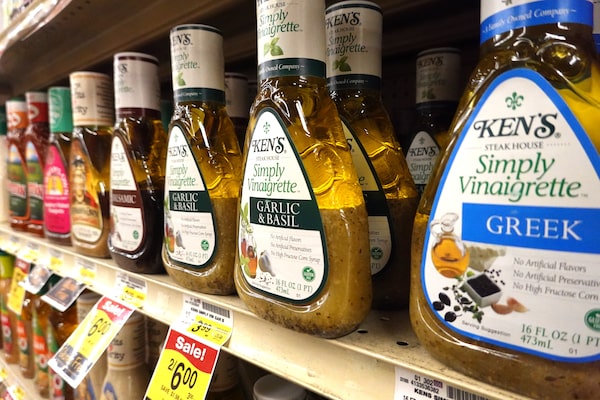
Salad dressing is offered for sale at a grocery store.Scott Olson/Getty Images
The question: What’s the healthiest salad dressing to buy – and what should I look for on the nutrition label?
The answer: If you don't have time to make your own salad dressing from scratch (which I recommend) there are many choices at the grocery store. But it's important to read the nutrition label to be sure you're getting a healthy fat and not too much sodium.
I don’t recommend fat-free dressings. Aside from the lack of flavour that’s typical of many of them, they can also rob you of antioxidants. That’s because oil in salad dressings helps the body absorb beta-carotene, lycopene and lutein, beneficial phytochemicals in salad greens. In fact, one study found that when people ate their salad with fat-free dressing, they absorbed almost none of these compounds.
Vinaigrette or creamy, all salad dressings are made with heart-healthy unsaturated vegetable oils. But some unsaturated oils are healthier than others. Salad dressings made with canola oil are a good choice because they contain alpha linolenic acid (ALA), an omega-3 fat that may protect from heart disease.
Why not cheat your way to a really good salad?
Some food companies have added other healthy oils such as flaxseed oil and hempseed oil, which increase the omega-3 fat content. Olive oil is also a healthy fat, but you won't find it as often as canola oil in commercial products.
Many store-bought salad dressings contain too much sodium, as much as 400 to 500 milligrams in two tablespoons. (The nutrition numbers on most salad dressing labels reflect a two-tablespoon serving.) Look for brands with less than 300 milligrams of sodium a serving.
Here’s a hint: Salad dressings with the lowest sodium numbers tend to be fruit flavoured.
Look at calories, too. A two-tablespoon serving of full-fat salad dressing can cost you anywhere from 90 to 180 calories. If you eat salad every day, choose a dressing that delivers no more than 100 calories a serving, which many oil and vinegar based dressings do.
And watch your portion size. Keep in mind if you use more that two tablespoons, you’ll need to multiply the numbers to see how many calories and how much sodium you’re consuming.
 Leslie Beck
Leslie Beck